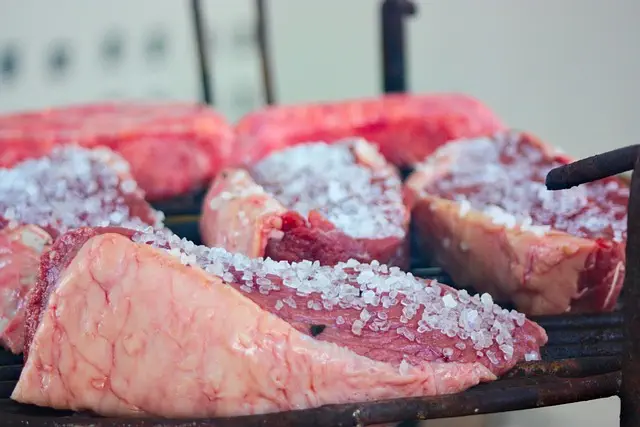Red Maeng Da Kratom, a potent strain from Southeast Asia, is celebrated for its unique alkaloid profile that includes 7-hydroxymitragynine and mitraphylline, which offer a blend of stimulating and sedative effects. This strain is known for its balanced impact, providing energy and mood enhancement at lower doses and pain relief and relaxation at higher dosages. Its long-lasting effects are attributed to the slow metabolism of its alkaloids, which also contribute to managing stress, anxiety, and chronic pain. Historically significant in Vietnam's cultural practices, Red Maeng Da is now a subject of international interest due to its potential as an alternative wellness supplement. It is essential for users to approach it with caution, adhering to recommended dosages and seeking professional advice, given the strain's potency and varying legal statuses. Understanding what Red Maeng Da does is crucial for those interested in exploring its effects on well-being and incorporating it responsibly into their health regimen.
Red Maeng Da Kratom leaves, indigenous to Vietnam, have garnered attention worldwide for their potent effects and distinct composition. This article delves into the unique attributes of Red Maeng Da, exploring its historical context, cultivation practices, and the role of alkaloids such as mitragynine and 7-hydroxymitragynine that set it apart from other kratom strains. We will uncover how these leaves are harvested, the effects they produce, and their therapeutic properties that may offer potential benefits. Join us as we examine what Red Maeng Da does and why it has become a subject of intrigue in herbal supplement circles globally.
- Unraveling the Potency of Red Maeng Da Kratom Leaves: An Overview
- The Historical Context and Origins of Red Maeng Da Kratom in Vietnam
- Composition and Effects: What Sets Red Maeng Da Apart from Other Strains
- Harvesting and Cultivation Practices: A Glimpse into the Farming of Red Maeng Da
- The Role of Alkaloids: Understanding Mitragynine and 7-Hydroxymitragynine in Red Maeng Da
- Exploring the Therapeutic Properties and Potential Benefits of Red Maeng Da Kratom
Unraveling the Potency of Red Maeng Da Kratom Leaves: An Overview

Red Maeng Da Kratom leaves have garnered significant attention within botanical circles and among users seeking natural alternatives for well-being. Often celebrated for their distinctive potency, these leaves from the Mitragyna speciosa tree are revered for their unique alkaloid composition, which is believed to contribute to their efficacy. The alkaloids present in Red Maeng Da, such as 7-hydroxymitragynine and mitragynine, interact with the body’s opioid receptors, potentially offering a range of effects including pain relief, mood enhancement, and increased energy levels. Users report that Red Maeng Da, due to its high alkaloid content, may have a more profound impact compared to other strains, making it a popular choice for those looking to experience the full spectrum of kratom’s benefits. The effects of Red Maeng Da are often described as balanced, providing a harmonious blend of stimulation and relaxation, which can be both invigorating and soothing. Users are advised to approach Red Maeng Da with caution due to its potency, ensuring proper dosage to align with their individual wellness goals and tolerances. Understanding the nuances of Red Maeng Da’s effects is crucial for anyone considering its use, as it is not merely a one-size-fits-all solution.
The Historical Context and Origins of Red Maeng Da Kratom in Vietnam

Red Maeng Da Kratom, a variant of Mitragyna speciosa native to the Southeast Asian country of Vietnam, has a history deeply intertwined with local traditions and folklore. The origins of this particular strain date back centuries, where it was traditionally used by indigenous peoples for its medicinal properties. These people, adept in the knowledge of local flora, recognized the unique effects of the Maeng Da leaves, which they chewed or brewed into tea. The name “Maeng Da” itself translates to “Phorus Horse,” reflecting the intense energy and strength that users reported after consuming it.
Historically, the cultivation and use of kratom in Vietnam were part of a rich cultural tapestry, with the plant being integrated into various aspects of daily life. The leaves were often employed as a natural remedy for pain relief, to enhance stamina during long work hours, and to alleviate fatigue. It wasn’t until more recent times that the international community became aware of this potent strain, particularly Red Vein Maeng Da, which is known for its balanced effects between energy and relaxation. Its reputation as a natural stimulant and analgesic has led to a growing interest in the West, where it has become a subject of scientific research and an alternative wellness product. The historical context of Red Maeng Da Kratom in Vietnam underscores its role as a multifaceted plant with a legacy of traditional use, now explored for its potential benefits.
Composition and Effects: What Sets Red Maeng Da Apart from Other Strains

Red Maeng Da kratom leaves are renowned for their distinct composition and pronounced effects, setting them apart from other strains within the Mitragyna speciosa family. The leaves of this strain contain a unique blend of alkaloids, most notably 7-hydroxmitragynine and mitragynine, which are responsible for its potent properties. These active compounds interact with the body’s opioid receptors, producing a balanced blend of stimulating and sedating effects, making Red Maeng Da a versatile choice for individuals seeking to enhance their well-being. Unlike other strains that may skew heavily towards energy or relaxation, Red Maeng Da offers a harmonious balance, often described as energizing without being overstimulating, and relaxing without causing drowsiness in excessive amounts. This duality makes it a popular choice for those looking to tackle the demands of daily life while maintaining a sense of calm. Additionally, Red Maeng Da is known for its long-lasting effects, providing sustained relief or energy as needed. Its unique composition and well-rounded effects have cemented Red Maeng Da’s place as one of the most sought-after kratom strains among users seeking to understand what Red Maeng Da does and how it can complement their lifestyle.
Harvesting and Cultivation Practices: A Glimpse into the Farming of Red Maeng Da

In the rich agricultural landscape of Vietnam, the cultivation of Red Maeng Da Kratom leaves is a practice deeply rooted in traditional farming methods combined with modern horticultural techniques. These leaves, renowned for their potent alkaloid profile, are harvested from the Mitragyna speciosa tree, a species indigenous to Southeast Asia. The optimal conditions for Red Maeng Da’s growth include a humid environment, ample sunlight, and nutrient-rich soil—factors that contribute to its high-quality yield. Farmers in Vietnam employ a selective pruning approach to encourage the bushy growth of the tree, ensuring a denser canopy and higher alkaloid content in the leaves. The harvesting process is meticulous, with experienced workers plucking the mature leaves by hand to preserve their integrity and potency. This careful selection and handling are crucial for maintaining the efficacy of Red Maeng Da Kratom, which is revered for its stimulating and euphoric effects. Additionally, sustainable farming practices are employed to protect the natural habitat and ensure the longevity of Kratom cultivation in Vietnam, making it a sustainable and environmentally friendly source of this sought-after herb. The end product, Red Maeng Da Kratom leaves, is then dried and processed for various markets worldwide, where it is celebrated for its unique effects and health benefits.
The Role of Alkaloids: Understanding Mitragynine and 7-Hydroxymitragynine in Red Maeng Da

Red Maeng Da kratom leaves are renowned for their potent alkaloid profile, which includes significant levels of mitragynine and 7-hydroxymitragynine. These compounds are at the core of what Red Maeng Da does within the body’s systems. Mitragynine, the primary active alkaloid in kratom, interacts with opioid receptors in the brain, providing analgesic effects and helping to manage pain. Its stimulating properties can also enhance mood and cognitive function, making it a popular choice for individuals seeking natural energy and focus enhancement. In addition to mitragynine, 7-hydroxymitragynine is another alkaloid that contributes to the unique effects of Red Maeng Da. It has been found to be more potent than mitragynine in some respects, particularly in its analgesic properties. This combination of alkaloids makes Red Maeng Da a versatile strain, often utilized for its pain-relieving, mood-elevating, and stimulating effects. Users report that the strain offers a balanced experience without the sedative effects typically associated with opioids, which is particularly appealing to those looking for an alternative to traditional pain management methods. The role of these alkaloids in Red Maeng Da kratom underscores the complexity of its effects and the need for further research to fully understand its potential applications and benefits.
Exploring the Therapeutic Properties and Potential Benefits of Red Maeng Da Kratom

Red Maeng Da kratom, a strain originating from the forests of Southeast Asia, has garnered attention for its distinctive alkaloid profile and the array of potential health benefits it may offer. This particular variety of Mitragyna speciosa, commonly known as kratom, is celebrated for its stimulating and euphoric effects at low doses, and its analgesic and sedative properties at higher doses. The active ingredients found in Red Maeng Da, namely 7-hydroxymitragynine and mitraphylline, are thought to contribute to its therapeutic potential. Users often report that Red Maeng Da kratom can help alleviate chronic pain, elevate mood, and enhance mental clarity. Its effects are known to be long-lasting due to the slow metabolism of its alkaloids. Moreover, advocates suggest that this strain may aid in managing stress and anxiety, offering a sense of relaxation without overwhelming drowsiness, making it a versatile option for individuals seeking natural alternatives to manage their well-being. As with any supplement or herb, it is crucial to approach Red Maeng Da kratom with caution, adhering to recommended dosages and consulting healthcare professionals when integrating it into one’s health regimen. Understanding the nuances of Red Maeng Da kratom’s effects requires careful consideration of individual physiology, as well as the legal status of kratom in one’s jurisdiction.
In concluding our exploration of Vietnam’s unique contribution to the kratom landscape, the Red Maeng Da kratom leaves stand out for their distinctive potency and therapeutic properties. The historical context and cultivation practices inherent to Vietnam have shaped this strain, making it a subject of significant interest in understanding its effects. With an emphasis on the alkaloids mitragynine and 7-hydroxymitragynine, which contribute to what Red Maeng Da does, users report a range of potential benefits. As with any botanical substance, it is important for individuals to approach Red Maeng Da with caution and to adhere to legal guidelines. The comprehensive overview presented here underscores the importance of responsible use and further research into the effects of this potent strain. Red Maeng Da kratom remains a fascinating subject within the broader context of natural remedies and herbal supplements, offering insights into its potential role in well-being.






